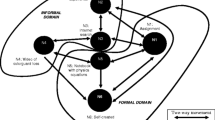Abstract
An analysis of student connections through time and space relative to the core discipline of physics is attempted, as viewed through the lens of actor-network-theory, by Antonia Candela. Using lenses of cultural realities, networks, and perceived power in the discourse of one specific university in the capital city of Mexico and one undergraduate physics classroom, the trajectories and itineraries of students are analyzed, relative to a physics professor’s pedagogical practices. This ethnographic study then yields comparisons between Mexican undergraduate students and students from the United States. Actor network theory recognizes that the symbiotic relationship existing between an actor and a continuum of space and time is defined by the symbiotic yet interdependent relationships and networks of practice (Lemke in Downward causation: Minds, bodies, and matter 2000). As part of this study and in line with actor-network-theory, human actors and non-human participants were viewed in relation to how subjects acted and were acted upon within networks of practice. Through this forum I reflect on this work with particular focus on the issues of situatedness of actors from a sociocultural perspective and how established networks viewed within this perspective frame and subsequently impact student trajectories and itineraries. In essence I argue for a need to look at a myriad of further complexities driving the symbiotic relationships being analyzed.
Resumen ejecutivo
Crear sentido y comprender el fenómeno socio-cultural que ocurre en la educación requiere descifrar las complejidades implícitas, reconociendo que lo obvio; lo que en la superficie aparece como simple, no es suficiente. Desde este punto de vista yo planteo la necesidad de identíficar lo que promueve la relación simbiótica que se presenta en el vínculo entre estudiantes en un programa de estudio universitario, y considero la necesidad de analizar estas complejidades para entender el significado inherente que contienen. Como resultado de mi reflexión sobre el artículo de Antonia Candela, titulado Tiempo y Espacio: Fisica en Movimiento, me refiero a la necesidad de ser más explícita en cuanto a los matices culturales que contibuyen a lo que ella estudia. El contexto en el cual se desarrolla este estudio presenta la unicidad cultural inherente en una realidad socio-política, y contribuye en gran parte a la trayectoría de los estudiantes que se describe en este estudio etnográfico. Este artículo presenta realidades culturales, redes y hasta percepciones de poder que establecen los estudiantes todavía no licenciados de física, en México, sin aclarar suficientemente su contexto. Candela intenta un interesante análisis sobre las conexiones de estudiantes a través del tiempo y espacio, relativo a la disciplina básica de la física, utilizando la teoría del actor-red. Yo afirmo que las normas culturales tácitas y la clase social de origen, definen el acceso de estudiantes a actividades y personas, es decir, que su capital cultural y social determina sus oportunidades durante su tránsito por el tiempo y el espacio de las trayectorías que se estudian en el artículo. La comparación entre estudiantes no licenciados de México y de los Estados Unidos es otra oportunidad para descifrar y hacer explícitos estos matices culturales. La teoría del actor-red reconoce que la relación que existe entre el “actor” y un continuo de espacio y tiempo se define por las simbióticas pero interdependientes relaciones y redes de práctica (Lemke in Downward causation: Minds, bodies, and matter 2000). Toda red de práctica está enmarcada en un contexto de complejidades y las legítimas comparaciones pueden contribuir al proceso de descifrarlas. Este estudio utiliza la teoría del actor-red, reconociendo tanto a los participantes humanos como tambien los no humanos, es decir, las estructuras que definen redes de practica. Estas estructuras se analizan en relación a cómo los sujetos actúan entre estas redes y como estas redes, accesibles o no, determinan esa practica. Esto es complejo y da apoyo a el argumento que se requiere descifrar estas complejidades para entender lo que en realidad ocurre determinando la trayectoria de estudiantes. En particular es importante reconocer que todos los estudiantes no están posicionados igualmente desde un punto de vista socio-cultural. Esta posición en la cual se encuentran los actores establece la manera en que las redes a su alcance en realidad determinan su trayectoría e itinerarios.
Similar content being viewed by others
References
Bourdieu, P. (1977). Cultural reproduction and social reproduction. In J. Karabel & A. H. Halsey (Eds.), Power and ideology in education (pp. 487–511). New York: Oxford University Press.
Bourdieu, P. (2001). The forms of capital. In M. Granovetter & R. Swedberg (Eds.), Sociology of economic life (pp. 96–111). Boulder, CO: Westview Press.
Bourdieu, P., & Passeron, J.-C. (1977). Reproduction in education, society and culture. Richard nice (tr.). London: Sage Publications. [1970].
Bourdieu, P., & Wacquant, J. D. (1992). An invitation to reflexive sociology. Cambridge: Polity Press.
Candela, A. (2009). Time and space: Undergraduate Mexican physics in motion. Manuscript submitted for publication.
Gallard, A. (2008a). Complexity and the universe of education. Forum on Public Policy.
Gallard, A. (2008b). We are more different than alike: Latinos/Latinas-hispanics. In W. M. Roth & K. Tobin (Eds.), World of science education: Handbook of research in North America (Vol. 1, pp. 353–368). North America: Sense Publishers.
Lareau, A., & Weininger, E. B. (2003). Cultural capital in educational research: A critical assessment. Theory and Society, 32, 567–606.
Lave, J., & Wenger, E. (1991). Situated learning: Legitimate peripheral participation. Cambridge: Cambridge University Press.
Lemke, J. L. (2000). Material sign processes and emergent ecosocial organization. In Revised chapter for P. B. Anderson et al. (Eds.), Downward causations: Minds, bodies, and matter (pp. 181–213). Denmark: Aarhus University Press.
Nespor, J. (1994). Knowledge in motion: Spaces, time and curriculum in undergraduate physics and management. Philadelphia, PA: Falmer Press.
Author information
Authors and Affiliations
Corresponding author
Rights and permissions
About this article
Cite this article
Zapata, M. Student trajectories in physics: the need for analysis through a socio-cultural lens. Cult Stud of Sci Educ 5, 729–734 (2010). https://doi.org/10.1007/s11422-010-9261-y
Received:
Accepted:
Published:
Issue Date:
DOI: https://doi.org/10.1007/s11422-010-9261-y




